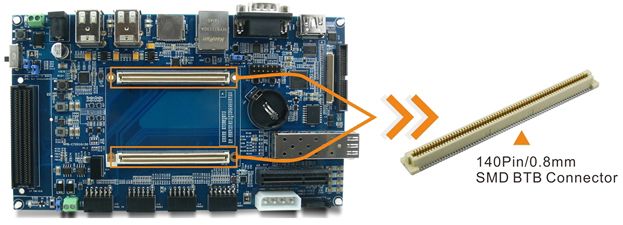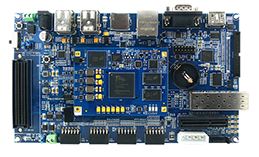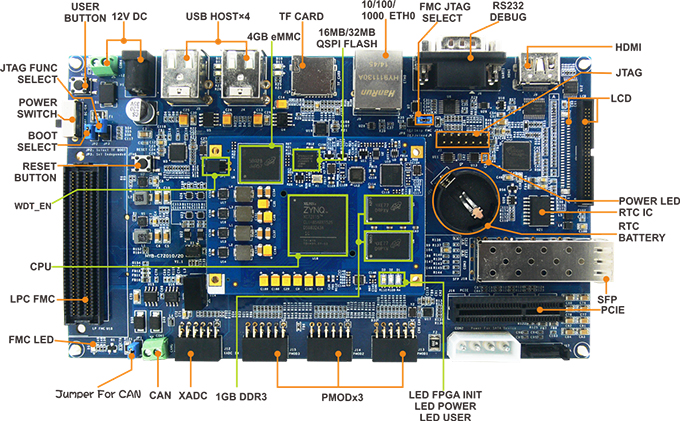MYD-C7Z015 Development Board
Deliveries:
South Africa: Price: R115, 2-4 working days.
International: Contact us for a quote.
Collections:
No Charge - 3 Appian Place, 373 Kent Ave, Randburg Effortlessly bridge legacy and modern technologies with our DB9 to USB Connector, enabling seamless connectivity between serial devices and USB ports.
All items subject to manufacturer's warranty. Extended 12 month warranty available at 20% of purchase price. t&c apply
MYD-C7Z015 Development Board
High Performant Boad Dual-core ARM Cortex-A9
The MYD-C7Z015 development board, designed by MYIR, features the Xilinx XC7Z015 (Z-7015) Dual-core ARM Cortex-A9 Processor and Xilinx 7-series FPGA logic. With PCIe and SFP interfaces, it suits various high-speed devices for applications like Industrial Automation, Medical Equipment, and Aerospace.
Powered by the MYC-C7Z015 CPU Module, the board integrates core components including Zynq-7015 processor, DDR3 SDRAM, eMMC, and more. With enhanced programmable functions, it offers versatile applications, supported by rich peripherals like RS232, USB, Gigabit Ethernet, HDMI, and PCIe interfaces.
The MYD-C7Z015 development board is preloaded with Linux and delivered with necessary cable accessories. It is a high-performance and low-cost development platform for evaluation and prototype based on Xilinx Zynq-7000 All Programmable SoC family.
Accessories:
12V/5A Power Supply
Features:
Mechanical Parameters
| Dimensions: 190mm x 110mm (base board), 75mm x 55mm (CPU Module) | |
| PCB layers: 4-layer design (base board), 12-layer design (CPU Module) | |
| Power supply: 12V/0.5A (base board), 5V/0.5A (CPU Module) | |
| Working temp.: -40~85 Celsius (industrial grade) |
Xilinx XC7Z015-2CLG485I (Zynq-7015)
- Four high-speed SerDes transceivers up to 6.25Gbps
- Four PCIe Gen2 hardened, integrated IP blocks
- 766MHz ARM® dual-core Cortex™-A9 MPCore processor (up to 866MHz)
- Integrated Artix-7 class FPGA subsystem with 74K logic cells, 46,200 LUTs, 160 DSP slices
- NEON™ & Single / Double Precision Floating Point for each processor
- Supports a Variety of Static and Dynamic Memory Interfaces
Memory:
| 1GB DDR3 (2 x 512MB, 32-bit) |
| 4GB eMMC |
| 1GB DDR3 (2 x 512MB, 32-bit) |
Peripherals and Signals Routed to Pins
| 10/100/1000M Ethernet PHY | |
| One USB PHY | |
| External watchdog | |
| Three LEDs | - One blue LED for power indicator - One red LED for FPGA program done indicator - One green user LED Two 0.8mm pitch 140-pin board-to-board expansion connectors bring out below signals: - One Gigabit Ethernet - One USB OTG 2.0 - Up to two Serial ports - Up to two I2C - Up to two CAN BUS Serial ports, I2C and CAN signals will be reused in PS part, or implemented through PL pins - One SPI (can be implemented through PL pins) - ADC (one independent differential ADC, 16-channel ADC brought out through PL pins) - One SDIO - Bank 13 (PL I/O configurable as up to 18 LVDS pairs and 1 single-ended I/O or 37 single-ended I/O) - Bank 34 (PL I/O configurable as up to 24 LVDS pairs and 2 single-ended I/O or 50 single-ended I/O) - Bank 35 (PL I/O configurable as up to 24 LVDS pairs and 2 single-ended I/O or 50 single-ended I/O) - Bank 112 (4 GTP serial transceivers, 2 reference clock input) |
PS Unit
| Four USB 2.0 Host ports (through USB Hub) |
| One RS232 (DB9 port) |
| One TF card slot (bootable) |
| One CAN interface |
| One 10/100/1000M Ethernet |
| One 2.54mm pitch 14-pin JTAG interface (PS, PL reused) |
| Battery backed RTC |
| One User Button (One I2C, can be connected to LCD and Resistive Touch Screen) |
| Jumpers - One for booting selection from TF card or QSPI - One for JTAG selection for using PS and PL reused or independent JTAG configured through PL pins - One for selection if adding FMC module to JTAG |
PL Unit
| One XADC interface |
| One Xilinx standard LPFMC interface |
| One HDMI interface (16-bit YCrCb, support 1080p display, do not support audio) |
| LCD/Touch screen interface (16-bit RGB, signals reused with HDMI, supports resistive and capacitive touch screen) |
| Two LEDs (one for FMC module detection, one for power indicator) |
| Three-channel PMoD |
| One SFP transceiver module with RJ45 interface (SFP-GE-T module, up to 1000Mbps) |
| One PCIe interface |
| OS Support Linux 5.4.0 |
The MYD-C7Z015 Base Board (MYB-C7Z015)

MYD-C7Z015 Base Board (MYB-C7Z015)




